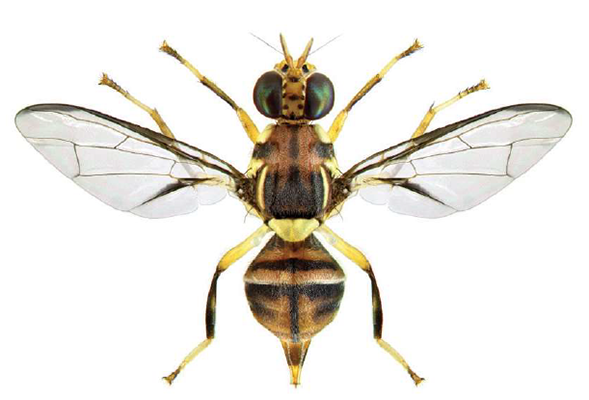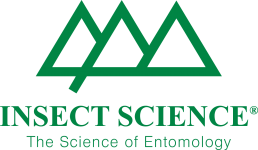Identification
The Asian fruit fly belongs to the Bactrocera dorsalis species complex and is therefore very similar to the other species in this group. To the untrained eye, the Asian fruit fly may at first be mistaken for a red and yellow wasp (Vespidae). This fruit fly bears some similarity to African fruit flies of the genus Dacus. The adults can be separated from the latter genus by looking for the following: a complete yellow scutellum; yellow longitudinal lines on the upper, lateral margins of the thorax; a dark “T” shape on the upper surface of the abdomen consisting of a dark band just anterior of the middle of the abdomen, with a medium, dark stripe running from this band to the posterior of the abdomen; all femora are yellow and hind tibiae are conspicuously dark; wings clear with a uniformly dark edge (continuous coastal band). The maggots are difficult to distinguish from other fruit fly species without molecular techniques.
Host plants
The Asian fruit fly is evidently highly polyphagous and over 70 wild and cultivated exotic host plants in more than 25 plant families have been recorded so far from Africa. Mango is preferred, followed by guava, papaya, banana, citrus and tomato. Other commonly cultivated hosts such as apple, peach, persimmon, coffee and avocado are also known.
Damage
The fruit fly devastates mango crops and in tropical Africa can result in much of the crop dropping before reaching maturity. It therefore has a large socio-economic impact in rural areas where people depend on mangos to supplement their income. Its effect on citrus is less devastating and it only attacks fruit shortly before maturity. Being an internal fruit pest, the Asian fruit fly is considered a quarantine pest and infested fruit will be rejected for export. Due to its absence from most export destinations, most countries will require a postharvest treatment or a system control approach before accepting fruit from an area known to be affected by this pest.
Life history
The Asian fruit fly is primarily a tropical species that prefers high relative humidity. In the tropics at low altitude it can be found throughout the year but its numbers decline during the dry season. At altitudes above 1000 m and during dry seasons it is less able to compete with Mediterranean fruit fly and marula fruit fly. The mean generation time is 31 days at an optimal temperature of 28 ˚C and the time from egg to adult, 25 days. Average net fertility is 608 eggs with a mean daily oviposition rate of 18 eggs. Adult females will survive for about 75 days.
Natural enemies
Being an introduced fly, little is known about the efficacy of indigenous parasitoids but in parts of Africa the foreign parasitoid Fopius arisanus (Sonan) is being released for biological control. Ants on the orchard floor will attack the larvae that are about to pupate and spiders attack the adult flies.
Management
As with other flies in the Bactrocera dorsalis complex, the Asian fruit fly can be attracted to methyl eugenol from up to 800 m away. This lure is therefore an excellent attractant for monitoring males in traps and for eliminating males with attract-and-kill techniques. Female flies can be monitored with Bio-lure® 3-component lure. Sanitation, or the removal of infested fruit from and under trees, is an essential part of management and should take place once a week. Infested fruit should be buried in the ground, at least 30 cm deep or chopped up finely. Flies can be controlled by using a combination of male annihilation techniques and bait sprays or bait stations. Male annihilation can take the form of mass trapping with traps containing methyl eugenol and an insecticide that are hung in trees at approximately 12 per hectare. Male annihilation alone may provide adequate control over a long period of time but usually baits or bait stations are required to reduce the number of females that damage the fruit. Baits are applied as large droplets at very low volumes so that little residue occurs on the fruit. Baiting must be implemented when the fruit start to colour as it will take a few weeks to reduce populations sufficiently.





